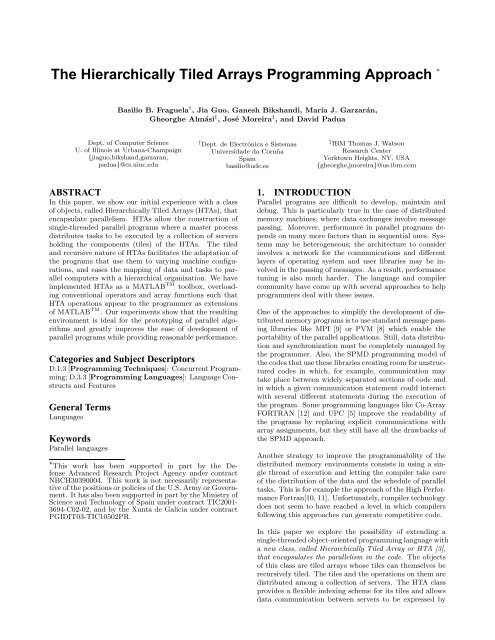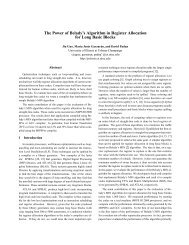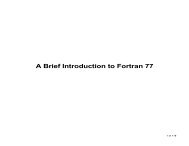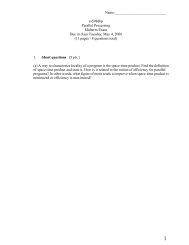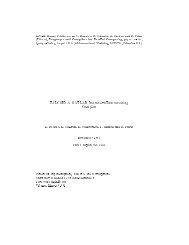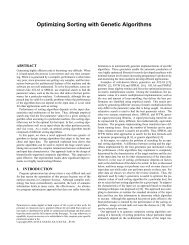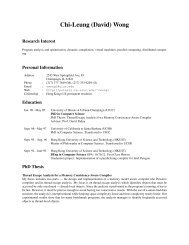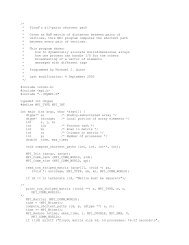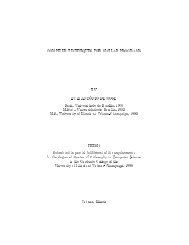The Hierarchically Tiled Arrays Programming Approach
The Hierarchically Tiled Arrays Programming Approach
The Hierarchically Tiled Arrays Programming Approach
Create successful ePaper yourself
Turn your PDF publications into a flip-book with our unique Google optimized e-Paper software.
<strong>The</strong> <strong>Hierarchically</strong> <strong>Tiled</strong> <strong>Arrays</strong> <strong>Programming</strong> <strong>Approach</strong> ∗Basilio B. Fraguela † , Jia Guo, Ganesh Bikshandi, María J. Garzarán,Gheorghe Almási ‡ , José Moreira ‡ , and David PaduaDept. of Computer ScienceU. of Illinois at Urbana-Champaign{jiaguo,bikshand,garzaran,padua}@cs.uiuc.edu† Dept. de Electrónica e SistemasUniversidade da CoruñaSpainbasilio@udc.es‡ IBM Thomas J. WatsonResearch CenterYorktown Heights, NY, USA{gheorghe,jmoreira}@us.ibm.comABSTRACTIn this paper, we show our initial experience with a classof objects, called <strong>Hierarchically</strong> <strong>Tiled</strong> <strong>Arrays</strong> (HTAs), thatencapsulate parallelism. HTAs allow the construction ofsingle-threaded parallel programs where a master processdistributes tasks to be executed by a collection of serversholding the components (tiles) of the HTAs. <strong>The</strong> tiledand recursive nature of HTAs facilitates the adaptation ofthe programs that use them to varying machine configurations,and eases the mapping of data and tasks to parallelcomputers with a hierarchical organization. We haveimplemented HTAs as a MATLAB TM toolbox, overloadingconventional operators and array functions such thatHTA operations appear to the programmer as extensionsof MATLAB TM . Our experiments show that the resultingenvironment is ideal for the prototyping of parallel algorithmsand greatly improves the ease of development ofparallel programs while providing reasonable performance.Categories and Subject DescriptorsD.1.3 [<strong>Programming</strong> Techniques]: Concurrent <strong>Programming</strong>;D.3.3 [<strong>Programming</strong> Languages]: Language Constructsand FeaturesGeneral TermsLanguagesKeywordsParallel languages∗ This work has been supported in part by the DefenseAdvanced Research Project Agency under contractNBCH30390004. This work is not necessarily representativeof the positions or policies of the U.S. Army or Government.It has also been supported in part by the Ministry ofScience and Technology of Spain under contract TIC2001-3694-C02-02, and by the Xunta de Galicia under contractPGIDIT03-TIC10502PR.1. INTRODUCTIONParallel programs are difficult to develop, maintain anddebug. This is particularly true in the case of distributedmemory machines, where data exchanges involve messagepassing. Moreover, performance in parallel programs dependson many more factors than in sequential ones. Systemsmay be heterogeneous; the architecture to considerinvolves a network for the communications and differentlayers of operating system and user libraries may be involvedin the passing of messages. As a result, performancetuning is also much harder. <strong>The</strong> language and compilercommunity have come up with several approaches to helpprogrammers deal with these issues.One of the approaches to simplify the development of distributedmemory programs is to use standard message passinglibraries like MPI [9] or PVM [8] which enable theportability of the parallel applications. Still, data distributionand synchronization must be completely managed bythe programmer. Also, the SPMD programming model ofthe codes that use these libraries creating room for unstructuredcodes in which, for example, communication maytake place between widely separated sections of code andin which a given communication statement could interactwith several different statements during the execution ofthe program. Some programming languages like Co-ArrayFORTRAN [12] and UPC [5] improve the readability ofthe programs by replacing explicit communications witharray assignments, but they still have all the drawbacks ofthe SPMD approach.Another strategy to improve the programmability of thedistributed memory environments consists in using a singlethread of execution and letting the compiler take careof the distribution of the data and the schedule of paralleltasks. This is for example the approach of the High PerformanceFortran[10, 11]. Unfortunately, compiler technologydoes not seem to have reached a level in which compilersfollowing this approaches can generate competitive code.In this paper we explore the possibility of extending asingle-threaded object-oriented programming language witha new class, called <strong>Hierarchically</strong> <strong>Tiled</strong> Array or HTA [3],that encapsulates the parallelism in the code. <strong>The</strong> objectsof this class are tiled arrays whose tiles can themselves berecursively tiled. <strong>The</strong> tiles and the operations on them aredistributed among a collection of servers. <strong>The</strong> HTA classprovides a flexible indexing scheme for its tiles and allowsdata communication between servers to be expressed by
Figure 2: Bottom up tiling.an assignment to be legal is that once it takes place, theadjacent tiles in the resulting HTA continue to have thesame size along each dimension of adjacency, that is, theresulting HTA continues to fulfill the properties of an HTA.2.4 Execution Model<strong>The</strong> machine model for an HTA program is that of a client,which runs the main thread of execution, and that is connectedto a distributed memory machine with an array ofprocessors, called servers, onto which the top-level tiles ofthe HTAs are mapped. Whenever an operation found inthe code that the client executes involves the distributedtiles of an HTA, such operation is broadcasted from theclient to the servers so that they execute it in parallel.When the operation only involves tiles that the serverowns, the server performs locally the computation. If, however,the computation requires tiles that the server doesnot own, it first requests them to the owner servers, andthen it performs the computation. Thus, in a programusing HTAs the parallelism and the communication is encapsulatedin the statements that operate on tiles of oneor more HTAs.While this is the execution model from the point of view ofthe programmer, and it is the way our current implementationworks, HTA programs could also be translated bya compiler into tasks that execute in the nodes of the arrayof processors synchronizing and exchanging data whenrequired. This is perfectly feasible approach that wouldimprove the scalability of this programming approach.2.5 Construction of HTAs<strong>The</strong> simplest way to build an HTA is by providing a sourcearray and a series of delimiters in each dimension wherethe array should be cut into tiles. For example, if M is a1000×1000 matrix, an HTA resulting from its partitioningin tiles of 100 × 250 elements would be created by thestatement:A = hta(M, {1:100:1000,1:250:1000});<strong>The</strong> triplet with the curly brackets are the partition vectorfor each dimension of the source array. <strong>The</strong> elements ineach partition vector specify the hyperplanes that cut theinput matrix along the corresponding dimension to distributeit in tiles. <strong>The</strong> elements in the partition vectormark the beginning of each sub-tile. This constructor canalso be used to create HTAs with different levels of tilingusing a bottom-up approach. For example, given a 10 ×12 matrix D, the statementsF= hta(a, {1:2:6, 1:2:6}, [2,2])matrix aP1 P2 P1P3 P4 P3P1 P2 P1distributedHTA Fmesh ofprocessorsFigure 3: Mapping of tiles to processors.C = hta(D, {[1,3,5,7,9],[1,4,7,10]});B = hta(C, {[1,4],[1,2,3,4]});A = hta(B, {[1,2],[1,2]});will generate the three HTAs shown in Fig. 2. Notice thatusing this bottom-up approach matrix A can also be createdusing a single statementA = hta(D, {[1,3,5,7,9],[1,4,7,10]}, ...{[1,4],[1,2,3,4]}, ...{[1,2],[1,2]});where the ... just mean the continuation of the commandin the following line.Finally, it is also possible to build empty HTAs whose tilesare later filled in. To build one, the HTA constructor mustbe called with the number of desired tiles per dimension.For example, F = hta(3, 3) would generate an empty 3×3 HTA F.<strong>The</strong> examples discussed above generate non-distributedHTAs, which are located only in the client. Nevertheless,most of the times we will be interested in generatingHTAs whose contents are distributed on a mesh of processors,so that we can operate in parallel on its tiles. Ourtoolbox currently supports a single form of distribution.Namely, it can distribute the top level tiles of an HTAcyclically on a mesh of processors. This corresponds toa block cyclic distribution of the matrix contained in theHTA, with the blocks defined by the top level partition.In order to achieve this, the constructor of the HTA needsa last parameter that specifies the dimensions of the meshby means of a vector. Fig. 3 shows an example where a
a = hta(MX,{dist}, [P 1]);b = hta(P, 1, [P 1]);b{:} = V;r = a * b;Figure 4: Sparse matrix vector product.for i = 1:nc = c + a * b;a = circshift(a, [0, -1]);b = circshift(b, [-1, 0]);endWhile the previous example only required communicationbetween the client, which executes the main thread, andeach individual server, Cannon’s matrix multiplication algorithm[4] is an example of code that also requires communicationbetween the servers.<strong>The</strong> algorithm has O(n) time complexity and uses O(n 2 )processors (servers). In our implementation of the algorithm,the operands, denoted a and b respectively, areHTAs tiled in two dimensions which are mapped onto amesh of n × n processors.Figure 5: Main loop in Cannon’s algorithm.6 ×6 matrix is distributed on a 2 ×2 mesh of processors asthe the last parameter of the HTA constructor indicates.In the future we plan to offer more mappings and a representationfor hierarchical organizations of processors.3. PARALLEL PROGRAMMING USING HTASIn this section we illustrate the use of HTAs with five simplecode examples.3.1 Sparse Matrix-Vector ProductOur first example, sparse matrix-vector product (Fig. 4),illustrates the expressivity and simplicity of our parallelprogramming approach. This code multiplies a sparse matrixMX by a dense vector V using P processors. We begin bydistributing the contents of the sparse matrix MX in chunksof rows into an HTA a by calling an HTA constructor. <strong>The</strong>P servers handling the HTA are organized into a single column.We rely on thedist argument to distribute the arrayMX in such a way that it results in a uniform computationalload across the servers.Next we create and empty HTA b distributed across allprocessors. We assign the vector V to each of the tilesin hta b (b{:}=V). With this assignment, the vector V iscopied to each tile of the hta b. Since HTA b is distributedacross the P processors, this copy requires that the clientbroadcasts V to all the servers that have a tile of the HTAb. Notice that since HTA b and a have the same numberof tiles and they are mapped to the same processor mesh,each processor holding a tile of a, will now hold a copy ofV too.<strong>The</strong> multiplication itself is in the last line of the code,where the binary operator * is invoked on a and b. <strong>The</strong>effect is that corresponding tiles of a and b, which arelocated in the same server, are multiplied, giving place toa distributed matrix-vector multiply. <strong>The</strong> result is a HTAr, distributed across the servers with the same mapping asthe inputs. This HTA can be flattened back into a vectorcontaining the result of the multiplication of a by b byusing the r(:) notation.<strong>The</strong> code completely hides the fact that MX is sparse becauseMATLAB TM provides the very same syntax for denseand sparse computations, a feature our HTA class implementationin MATLAB TM has inherited.3.2 Cannon’s Algorithm for Matrix MultiplicationIn each iteration of the algorithm’s main loop each serverexecutes a matrix multiplication of the tile of a and b thatcurrently reside on that server. <strong>The</strong> result of the multiplicationis accumulated in a (local) tile of the result HTA,c. After the computation, the tiles of a and b are circularshiftedas follows: the tiles of b are shifted along the firstdimension; the tiles of a are shifted along the second dimension.<strong>The</strong> effect of this operation is that the tiles of aare sent to the left processor in the mesh and the tiles of bare sent to the upper processor in the mesh. <strong>The</strong> left-mostprocessor transfers its tile of a to the right-most processorin its row and the bottom-most processor transfers its tileof b to the top-most processor in its column.At the end of n iterations each server holds the correctvalue for its associated tile in the output HTAc=a*b. Fig. 5shows the main loop of Cannon’s algorithm using HTAs.3.3 Jacobi RelaxationReferencing arbitrary elements of HTAs results in complexcommunication patterns. <strong>The</strong> blocked Jacobi relaxationcode in Fig. 6 computes the new value of each elementas the average of its four neighbors. Each block of d×delements of the input matrix is represented by a tile ofthe HTA v. In addition, the tiles also contain extra rowsand columns for use as border regions for exchanging informationwith the neighbors. As a result, each tile hasd+2 rows and d+2 columns. This situation is depicted inFig. 7, which shows an example 3 × 3 HTA v with d= 3.<strong>The</strong> inner part of each tile, surrounded by a dotted line inthe picture, contains the data from the input matrix. <strong>The</strong>first and last row and column in each tile are the shadowsthat will receive data from the internal tile of the neighborsin order to calculate locally the average of the fourneighbors for each element. This exchange of shadows isexecuted in the first four statements of the main loop andit is also illustrated in Fig. 7, which shows the executionof the statement v{2:n,:}(1,:) = v{1:n-1,:}(d+1,:).As we see, by using HTA addressing, communication andcomputation can be easily identified by looking at the tiledindexes.In this case the flattened version of the HTA v does notquite represent the desired end result, because of the existenceof the border exchange regions. However, the desiredmatrix can be obtained by first removing the borderregions and applying the flattening operator afterward:(v{:,:}(2:d+1,2:d+1))(:,:).3.4 Embarrassingly Parallel ProgramsEasy programming of embarrassingly parallel and MIMDstyle codes is also possible using HTAs thanks to theparHTAFunc
¡ ¡ ¡ ¡ ¡ ¡ ¡¡ ¡ ¡ ¡ ¡ ¡ ¡while ~convergedv{2:n,:}(1,:) = v{1:n-1,:}(d+1,:);v{1:n-1,:}(d+2,:) = v{2:n,:}(2,:);v{:,2:n}(:,1) = v{:,1:n-1}(:,d+1);v{:,1:n-1}(:,d+2) = v{:,2:n}(:,2);u{:,:}(2:d+1,2:d+1) = K * (v{:,:}(2:d+1,1:d) + v{:,:}(1:d,2:d+1) + ...v{:,:}(2:d+1,3:d+2) + v{:,:}(3:d+2,2:d+1));endFigure 6: Parallel Jacobi relaxation¨ ¨ ¨ ¨ ¨ ¨© © © © © © ©¨¨ ¨ ¨ ¨ ¨ ¨ ¨© © © © © ©©© © © © © ©© ¨ ¨ ¨ ¨ ¨ ¨ ¨¦ ¦ ¦ ¦ ¦ ¦§ § § § § § §¦¦ ¦ ¦ ¦ ¦ ¦ ¦§ § § § § §§§ § § § § §§ ¦ ¦ ¦ ¦ ¦ ¦ ¦¡ ¡ ¡ ¡ ¡ ¡ ¡¤ ¤ ¤ ¤ ¤ ¤¥ ¥ ¥ ¥ ¥ ¥ ¥¤¤ ¤ ¤ ¤ ¤ ¤ ¤¥ ¥ ¥ ¥ ¥ ¥¥¥ ¥ ¥ ¥ ¥ ¥¥ ¤ ¤ ¤ ¤ ¤ ¤ ¤ ¢ ¢ ¢ ¢ ¢ ¢£ £ £ £ £ £ £¢¢ ¢ ¢ ¢ ¢ ¢ ¢£ £ £ £ £ £££ £ £ £ £ ££ ¢ ¢ ¢ ¢ ¢ ¢ ¢Figure 7: HTA v in the Jacobi relaxation code.<strong>The</strong> shared areas indicate the regions of data thatare moved in the first statement of the loop.input = hta(P, 1, [P 1]);input{:} = eP;output = parHTAFunc(@estimatePi, input);myPi = mean(output(:));function r = estimatePi(n)x = randx(1, n);y = randx(1, n);pos = x .* x + y .* y;r = sum(pos < 1) / n * 4;Figure 8: Estimation of π using parallel MonteCarlofunction. It allows the execution of a function in parallelon different tiles of the same HTA. A call to this functionhas the form parHTAFunc(func, arg1, arg2, ...),where func is a pointer to the function to execute in parallel,and arg1, arg2,. . . are the arguments for its execution.At least one of these arguments must be a distributed HTA.<strong>The</strong> function func will be executed in the servers that holdthe tiles of the distributed HTA. For each local execution,the distributed HTA in the list of input arguments is replacedby the local tile of each server. If the server keepsseveral tiles, the function will be executed for each of these.Several arguments toparHTAFunc can be distributed HTAs.In this case they all must have the same number of tiles inevery dimension and the same mapping. This way, in eachlocal execution, the corresponding tiles of the HTAs, whichreside in the same server, are used as inputs for func. <strong>The</strong>result of the parallel execution is stored in an HTA (or several,if the function has several outputs) that has the samenumber of tiles and distribution as the input distributedHTA(s).Fig. 8 illustrates a parHTAFunc that estimates π using theMonte Carlo method on P processors. A distributed HTAinput with one tile per processor is built. <strong>The</strong>n its tilesare filled with eP, the number of experiments to run inevery processor. <strong>The</strong> experiments are made on each processorby the function estimatePi defined in Fig. 8, whoseinput argument is the number of experiments to make.MATLAB TM syntax is used throughout the code to definetheestimatePi function, designate its pointer@estimatePi,and the different operations required by the function, suchas .*, the element-by-element product of two arrays. <strong>The</strong>function randx is similar to rand in MATLAB TM but generatesa different sequence on each processor. <strong>The</strong> result ofthe parallel execution of the function is a distributed HTAoutput that has the same mapping as input and keeps asingle tile per processor with the local estimation of π. Tocompute the global estimation, which is the mean of thesevalues, the standard MATLAB TM function mean is appliedto the flattened output.<strong>The</strong> global estimation is the mean of these values, so thestandard MATLAB TM function mean is applied to the flattenedoutput to calculate this value.3.5 Non-Numerical ProblemsAll the previous examples are numerical computing. We oftenwonder whether new parallel programming paradigmsare only suitable for this kind of applications. For thisreason, in this section we describe a parallel HTA implementationof quicksort. <strong>The</strong> code is shown in Fig. 9. <strong>The</strong>program sorts an input vectorvwithnum el elements usingP processors in log 2 (P) steps.<strong>The</strong> program uses the Hyperquicksort algorithm [13]. <strong>The</strong>algorithm regards the mesh of processors as a linear arraywhere the processors are numbered from 1 to P. <strong>The</strong> algorithmstarts by distributing the input vector v amongthe processors. <strong>The</strong>n, each processor sorts each subset usingthe sort MATLAB TM function. <strong>The</strong> algorithm proceedsin log 2 (P) iterations starting with i ranging from log 2 (P)to 1. Each iteration i divides the processors into sets of 2 iconsecutive processors. Each processor set has a pivot thatis used to partition the data. At each iteration i, the datais rearranged such that the 2 i−1 processors in the upperhalf of the processor set contain the values greater thanthe pivot, and the processors in the lower half contain thesmaller values.Each iteration starts by choosing a pivot in each tile ofthe HTA h in which the input vector has been partitioned.This is done by applying the function pivotelement inparallel in every chunk, which chooses the value in themiddle of the chunk, or 0 if the tile is empty. <strong>The</strong>n, the
num_el = length(v);h = hta(v, {1:ceil(num_el/P):num_el}, [P 1]);h = parHTAFunc(@sort, h);for i = log2(P):-1:1% First stagepivot = parHTAFunc(@pivotelement, h);initSet = 1:2^i:P;pivot{:} = pivot{sort(repmat(initSet, 1, 2^i))};% Second stage[l, u] = parHTAFunc(@partition, h, pivot);% Third stagetmpU = initSet;for j=1:2^(i-1)-1tmpU = [tmpU initSet+j];endtmpU = sort(tmpU);tmpL = setdiff(1:P, tmpU);tmptu = u{tmpU};u{tmpU} = l{tmpL};l{tmpL} = tmptu;% Fourth stageh = parHTAFunc(@cat_sort, l, u);end% <strong>The</strong> following functions process each tilefunction t = pivotelement(h)n = size(h,1);half = ceil(n/2);if halft = h(half);elset = 0;endfunction [l, u] = partition(h, pivot)l = h(hpivot);function r = cat_sort(l, u)r = sort(cat(1, l, u));Figure 9: Parallel quicksortpivot in the first processor in each set (variable initSetkeeps the indexes of these processors) is broadcasted to theother processors in the set by means of an assignment inthe HTA pivot.In the second stage of the algorithm, each processor partitionsits local chunk in two subsets by running the functionpartition. For each processor, the tiles of the HTAl contain the elements that are smaller than or equal tothe pivot; while the tiles of the HTA u contains the greaterones.In the third stage, the tiles of HTAs l and u are exchangedwithin each half of each set of 2 i consecutive processors.<strong>The</strong> processors in the first half of each set send their utiles to the processors in the second half, which, in return,will send their l tiles. <strong>The</strong> swapping of tiles is achievedby means of assignments, after calculating the correct indexesfor the operation. Notice that once the exchangecompletes, all the data in the tiles of both l and u in thefirst 2 i−1 processors of each set is smaller than (or equalto) the pivot used for the sorting of the set; while the datain the tiles of the processors of the second half of the setis bigger than the pivot.<strong>The</strong> fourth and final stage of the algorithm takes care offusing the tile of l and the tile of u that reside in eachprocessor and sorting locally the result. This is achievedby applying in parallel the function cat sort to the HTAsl and u. <strong>The</strong> result is a regenerated HTA h.4. IMPLEMENTATIONHTAs can be added to almost any object-based or objectorientedlanguage. We chose the MATLAB TM environmentas the host for our implementation for a number ofreasons:• MATLAB TM is a linear algebra language with a largebase of users who write scientific code. HTAs allowthese users to harness the power of a cluster of workstationsinstead of a single machine.• MATLAB TM is polymorphic, allowing HTAs to substituteregular arrays almost without changing therest of the code, thereby adding parallelism painlessly.• MATLAB TM is designed to be extensible. Thirdparty developers can provide so-called toolboxes offunctions for specialized purposes. MATLAB TM alsoprovides a native method interface called MEX, whichallows functions to be implemented in languages likeC and Fortran.In the MATLAB TM environment, HTAs are implementedas a new type of object and they are built through theconstructors described in Section 2.5. <strong>The</strong> bulk of theHTA implementation is actually written in C and interfaceswith MATLAB TM through MEX. In general, methodsthat do not involve communications, such as those thattest the legality of operations, were written in MATLAB TMto simplify their development. Small methods used veryfrequently were written in C for performance reasons. Bothclient and servers have a copy of matlab and HTA systemon top of it. Communications between the client and theservers are implemented using the MPI [9] library, thusmethods that involve communication were written in C inorder to use the message-passing library.Our implementation supports both dense and sparse matriceswith double precision data, which can be real or complex.Any number of levels of tiling is allowed in the HTAs,although every tile must have the same number of levelsof decomposition in order to simplify the legality tests. Inpractice this is not an important restriction, since an HTAcan consist of a single tile that holds another HTA or a matrix.Also, the current implementation requires the HTAsto be either full (every tile has some content) or empty(every tile is empty).4.1 Internal Structure<strong>The</strong> architecture of our MATLAB TM implementation isshown in Fig. 10. MATLAB TM is used both in the client,where the code is executed following a single thread, andin the servers, where it is used as a computational enginefor the distributed operations on the HTAs. All the
UserMATLAB MATLAB Figure 10: HTA implementation in MATLAB TMcommunications are done through MPI; the lower layersof the HTA toolbox take care of the communication requirements,while the higher layers implement the syntaxexpected by MATLAB TM users.HTA programs have a single thread that is interpretedand executed by the MATLAB TM ’s client. <strong>The</strong> HTAsare just objects within the environment of the interpreter,that when referenced generate calls to the methods of theirclass. When an HTA is local, that is, when it is not distributedon the array of servers, the client HTA keeps boththe structure and the content of the HTA. When it is distributed,the HTA in the client holds the structure of theHTA at all its levels, although it does not contain its content.It also keeps the information of the mapping of thetop level tiles of the HTA on the mesh of servers. In thisway, for any operation, regardless whether the HTA is localor distributed, the client is able to locally:• test the legality of the operation• calculate the structure and mapping of the outputHTA(s)• send the messages that encode the command and itsarguments to the servers.Usually the legality check involves no communication, andthe client is able to generate locally the output HTAs ofthe distributed operations. An advantage of this approachis once the client broadcasts the commands, it is free tocontinue and execute the next statement/operation. Onthe other hand, doing all checking in the client creates abottleneck in the client, thus serializing part of the execution.A source of inefficiency in our current implementation isthat the client uses point to point communication ratherthan broadcasting. This was done so that servers wouldknow that every message a server receives corresponds toan operation in which it participates. This saves the teststhat would be required if the messages were broadcasted.This strategy reduced the development time for the toolbox,but it is slower than using the broadcast, particularlyas the number of servers increases.<strong>The</strong> servers have the structure and data of the top levelHTA tiles that are mapped to them, but they also knowthe structure of the HTAs that are not mapped to them.So, when a HTA is not mapped to a server, the serverknows the number of dimensions of the HTA, the numberof tiles per dimension at the top level, and the size of eachtop level tile in each dimension in terms of elements, as wellas which servers owns each tile. In practice, this allows theservers very often to calculate which server(s) must be thedestination or the source of their messages when they needto exchange data.4.2 MATLAB TM Specific Implementation IssuesA difficulty we found is the lack of destructor in the MATLAB TMclasses. This hindered our ability to destroy distributedHTAs because the HTA subsystem is not notified when anHTA instance is destroyed by the MATLAB TM .Our solution to this problem is to apply a garbage collectionmechanism based on a pattern of changes that wehave detected in the internal structure of an HTA whenMATLAB TM destroys it. Whenever a distributed HTAis built, a record of its internal structure is created inthe client. <strong>The</strong> constructor checks for changes in otherdistributed HTA structures. If any changes are detected,we know that the corresponding HTA has been destroyedand we ask the servers to destroy their components of thedeleted HTAs.Our implementation follows the copy-on-write behavior ofMATLAB TM . In a MATLAB TM assignment, the RHS isnot actually copied, but rather a reference is created fromthe LHS of the assignment to the old value. A copy isonly made when the user attempts to modify the data referredto. Since our HTAs are implemented with the samevariables that MATLAB TM uses, an HTA can have multiplereferences to it. Private copies of distributed HTAsare made only when they have several handles/names inthe program and some of them modify the contents of theHTA.5. EVALUATION5.1 Environmental Setup
Our toolbox has been implemented and tested in an IBMSP system, an HP HPC320 server with alpha processorsand True64 OS, and in a small cluster of PCs with Linux.We present experimental results for the IBM SP system.Most of our measurements were done on in IBM SP systembecause of its higher availability, larger number of processorsand more MATLAB TM licenses available to us.Our IBM SP system consists of two nodes. Each node has8 Power3 processors that run at 375 MHz and 8 GB ofmemory. Two configurations have been used in the experiments:one with 2 × 2 mesh of 4 servers, and another onewith 3 ×3 mesh of 9 servers. Each node contributes half ofthe servers. <strong>The</strong>re is an additional processor that executesthe main thread of the program, thus acting as the clientor master of the system.<strong>The</strong> computational engine and interpreter for our HTAtoolbox was implemented using MATLAB TM R13 (Section4). <strong>The</strong> C files of the toolbox were compiled with theVisualAge C xlc compiler for AIX, version 5.0, with theO3 flag. <strong>The</strong> MPI library used was the one provided bythe IBM parallel Environment for AIX, version 3.1. Serialand parallel MATLAB TM benchmarks were executedin this framework.Two series of benchmarks were used to evaluate the HTAtoolbox. <strong>The</strong> first one consists of five simple kernels: smvimplements the sparse matrix vector product shown inFig. 4 and described in Section 3.1; cannon is an implementationof Cannon’s matrix multiplication algorithm [4],whose main loop is depicted in Fig. 5; jacobi is the Jacobirelaxation code shown in Fig. 6; summa represents theSUMMA [7] matrix multiplication algorithm; and finallylu is an implementation of the LU factorization algorithm.Our second set of benchmarks consists of the well-knownep, mg, ft and cg NAS benchmark, version 3.1 [1].Four versions of each benchmark were written: two serialprograms, one in MATLAB TM and the other one inC/Fortran, and two parallel versions, one implemented usingHTAs and the other one using MPI+C/Fortran. In theMPI implementation of the benchmarks the blocks weremapped to the mesh of processors in the same way theHTAs do.<strong>The</strong> computational engine and interpreter for our HTAtoolbox was implemented using MATLAB TM R13 (Section4). <strong>The</strong> C files of the toolbox were compiled with theVisualAge C xlc compiler for AIX, version 5.0, with theO3 flag. <strong>The</strong> MPI library used was the one provided bythe IBM parallel Environment for AIX, version 3.1. ParallelMATLAB TM benchmarks were executed in this framework.Serial benchmarks were executed using the plainMATLAB TM R13.<strong>The</strong> serial C and MPI implementations for cannon, summaand lu were implemented using the IBM ESSL library,while the corresponding MATLAB TM HTA codes use theMATLAB TM libraries, which are less optimized. <strong>The</strong> Ccodes were compiled with the xlc compiler with the O3flag. <strong>The</strong> fortran codes (serial and MPI versions of NASbenchmarks) were compiled using the xlf compiler fromIBM also with the O3 flag. <strong>The</strong> MPI library used was MPIIBM Parallel Environment for AIX, version 3.1.Speedup4.543.532.521.510.50HTAMPI+C/Fortransmv cannon jacobi summa luBenchmarksFigure 11: Speedup for HTA and MPI+C/Fortranon 4 servers for the simple kernelsSpeedup9876543210HTAMPI+C/Fortransmv cannon jacobi summa luBenchmarksFigure 12: Speedup for HTA and MPI+C/Fortranon 9 servers for the simple kernelsFinally, notice that although the main focus of our workis the achievement of parallelism, HTAs can also be usedto express locality. In fact, we have run experiments thatshow that when multiplying matrices of sizes larger than2000 × 2000, an implementation based on HTAs, but executedserially, can run 8% faster than the native MATLAB TMmatrix product routine.In the next Sections we evaluate the performance and theease of programming of the MPI and the HTA approachto write parallel programs.5.2 Performance Analysis5.2.1 Simple benchmarksFigs. 11 and 12 show the speedup obtained by the simplekernels for the HTA and MPI+C/Fortran when running on4 and 9 servers, respectively. <strong>The</strong> speedup of the HTA parallelversions is computed from the parallel MATLAB TM
HTA execution time and the corresponding execution timeof the serial MATLAB TM . Likewise, the speedup of theMPI approach is computed using the execution time of thesequential C/Fortran and the MPI+C/Fortran programs.For both configurations, 4 and 9 servers, all the benchmarksare evaluated using matrices of size 4800 × 4800.<strong>The</strong> input sparse matrix of smv has a density of 20%.<strong>The</strong> figures show that the speedups of cannon and summausing HTAs are similar or even better than those of theMPI+C/Fortran programs. However, for smv, jacobi andlu the speedups of the MPI+C/Fortran versions is betterthan the speedups of the HTA ones, except the speedup oflu using 4 processors is similar in both cases.Time (Seconds)25020015010050HTAMPI<strong>The</strong> low speedups of the HTA codes are due to extra overheadsbuilt into our implementation. One cause of extraoverhead is the broadcast of HTA commands to theservers: all HTA operations need to be broadcast from theclient, who executes the main thread, to the servers, beforethey get executed. This approach simplifies implementationand implicitly synchronizes the processors, which inturn eases programming; but if the HTA operation handlesrelatively small amounts of raw data, broadcast overheaddominates execution time. By comparison, in an MPI programthis broadcast is unnecessary because program executionis governed locally.0ep mg ft_1d ft_2d cgFigure 13: Execution time for HTA andMPI+C/Fortran on 4 servers for the NAS benchmarks120100HTAMPIAnother source of overhead is due to the limitations of theMATLAB TM extension interface. Whenever a subset ofpositions of a tile is to be modified in an HTA method, acopy of the whole tile must be done. Copying an HTA inevery assignment is another source of overhead. This effectis particularly visible in the speedups of lu and jacobibecause they require the modification of portions of tilesrather than whole tiles. <strong>The</strong> reason for this copy is thatin MATLAB TM every parameter is passed to user-definedfunctions and methods by value. MATLAB TM itself doesnot suffer from this overhead, because the indexed assignmentoperation is a built-in function to which argumentsare passed by reference.Time (Seconds)806040200ep mg ft_1d ft_2d cgAs we see, the current sources of overheads are mostlydue to implementation issues and not inherent limitationsof the HTA approach. <strong>The</strong> overhead due to the broadcastof the HTA commands can be mitigated by sendingpre-compiled snippets of code to the servers for execution(although this implies the existence of a compiler). Byre-implementing the indexed assignment method in C insteadof MATLAB TM we can mitigate the overhead causedby excessive copying of HTAs.Finally, notice that the absolute execution time of the parallelMATLAB TM programs based on HTAs is at most afactor of two slower than their MPI counterparts. Thisshows that the overhead introduced by MATLAB TM inthese codes is not very high and therefore the speedupsobtained are mainly the result of parallelizing useful computationand not due to parallelization of the overhead.5.2.2 NAS benchmarksFigures 13 to 16 show the absolute execution time and thespeedup obtained using 4 and 8 servers (processors) forboth MPI and HTA programs for the NAS benchmarks,Figure 14: Execution time for HTA andMPI+C/Fortran on 8 servers for the NAS benchmarkswhich must be run using a number of servers that is apower of two. <strong>The</strong> labels ft 1d and ft 2d correspond to ftwith 1-D and 2-D decomposition respectively. That is the3-D array whose forward and inverse FFT are calculated inthe benchmark is partitioned either along only one (ft 1d ortwo ft 2d of its dimensions. We use the inputs of the class Aof the NAS benchmarks. So, the size of the input for mg is a256 ×256 ×256 array, while for ft it is 256 ×256 ×128. Forthe kernel ep 536870912 random numbers are generated;finally, the input for cg is a 14000 × 14000 sparse matrixwith 1853104 nonzeros and a vector of size 14000.Figures 13 and 14 show that the parallel execution time ofthe HTA implementation takes longer than the MPI one.However, remember that our HTA system is built on topof MATLAB TM which is a slow interpreted environment.However, Figures 15 and 16 show that the speedup of eachbenchmark is significant.
Speedup9876543210HTAMPIep mg ft_1d ft_2d cgFigure 15: Speedup for HTA and MPI+C/Fortranon 4 servers for the NAS benchmarksSpeedup15105HTAMPITable 1 shows the lines of code used by each benchmarkwith each of the 4 different implementations: MATLAB TM ,HTA, C/Fortran, and MPI. Unsurprisingly, MATLAB TMand HTA based programs take fewer lines of code than C,Fortran and MPI programs. In the case of smv, cannon,jacobi, summa and lu the difference is of an order of magnitude.For the NAS benchmarks, the HTA programs arebetween 30% and 70% of the MPI program.If we compare the implementation of HTA and MPI withtheir corresponding serial versions MATLAB TM and C/Fortran,respectively, the results in Table 1 show that the code sizesof smv, cannon, summa and lu increase substantially whengoing from serial to parallel. <strong>The</strong> reason is that one-lineinvocation of the matrix multiply in the serial program isreplaced by a whole parallel algorithm. In jacobi, ep, mgand cg the same algorithm is implemented in both the serialand parallel version, so the code size doesn’t changesignificantly. Finally, ft grows more than other benchmarkswhen going from serial to parallel, particularly in its MPIversion. This increase is because ft contains two parallelversions of the same problem: a 1-D version, that partitionsalong only one dimension of the tridimensional arraywhose forward and inverse FFT are calculated; and a 2-Dversion that partitions the array along two dimensions.It is also worth noting that the time we spent implementingthe HTA versions of the programs was much shorter thanthe time required for implementing the MPI+C/Fortranversions. HTA programs are much easier to write thanMPI programs. A functional HTA programs can be obtainedtrivially by changing array initializations into HTAinitializations; performance tuning is mostly accomplishedby rearranging indexing in the code in an incremental fashion.Writing an MPI based algorithm requires much morework in planning and thinking, in order to avoid data races,deadlock situations and to get good performance.0ep mg ft_1d ft_2d cgFigure 16: Speedup for HTA and MPI+C/Fortranon 8 servers for the NAS benchmarks<strong>The</strong> embarrassing parallelism of the kernel ep allows it toachieve a perfect speedup, since there is no communicationoverhead apart from the initial distribution and finalreduction. <strong>The</strong> kernel ft has a super-linear speedup for theHTA implementation. In ft the timing also includes theinitialization of the complex array with random entries.This takes a long time in a serial MATLAB TM program,which we believe is due to cache and/or TLB misses. <strong>The</strong>speedup of the HTA version of the kernel mg is slightlysmaller than that of its MPI version. Finally, the kernel cgdoes much better in MPI than with HTAs; mainly due tothe high optimization of the somewhat irregular patternsof communication in the MPI version. <strong>The</strong> reasons for theadditional overheads discovered in these programs are thesame as the ones commented before for the simple kernels.<strong>The</strong> readers should also note that the NAS benchmark kernelsare highly optimized, while our current HTA versionsare not that optimized.5.3 Ease of programming6. RELATED WORKLanguages for Parallel <strong>Programming</strong> have been an objectof research for a very long time. Several experimental languagesand compilers have been developed so far. Prominentamong them is High Performance Fortran [2]. HPF isan extension to FORTRAN that provides new constructsto define the type of data distribution and mapping ofdata chunks into processors. However, a key drawbackin HPF is the inability to operate on a tile (chunk) as awhole. <strong>The</strong> programmer must explicitly compute the tilesizes and their indexes for each distributed array for eachprocessor. <strong>The</strong> second drawback is the lack of transparencyin communication of data elements across processors. Forinstance, the main loop in the matrix multiplication programusing cannon’s algorithm implemented with HPF isshown in Fig. 17. <strong>The</strong> code in the figure assumes blockdistribution along both the dimensions of the matrices.A more closely related work to ours is ZPL [6]. ZPL definesa region of a specified shape and size that can bedistributed using any specified distribution on any specifiedgrid. Using the indexed sequential arrays, onecan build a structure similar to HTA, with operations ontiles as a whole. However, ZPL is still not transparent tothe programmer and it is of higher level than HTA. Forinstance, in ZPL the programmer never knows where and
Table 1: Lines of code in 4 different implementations of each benchmarkBenchmark smv cannon jacobi summa lu ep mg ft cgMATLAB 6 1 31 1 1 136 1202 114 192HTA 9 18 41 24 24 168 1500 157 203C/FORTRAN 100 14 48 14 33 205 1542 261 263MPI 176 189 364 261 342 242 2443 491 612for i= 1, nprowblocksize = n/nprowFORALL (j=1:nprow, k=1:npcol)j_b = (j-1)*blocksize + 1j_e = j_b + blocksize - 1k_b = (k-1)*blocksize + 1k_e = k_b + blocksize - 1c( j_b:j_e, k_b:k_e) = c( j_b:j_e, k_b:k_e) + &matmul(a(j_b:j_e, k_b:k_e), b(j_b:j_e, k_b:k_e))ENDFORALLa = cshift( a, blocksize, 2 )b = cshift( b, blocksize, 1 )enddoFigure 17: HPF - Main loop in Cannon’s algorithm.region R = [1..n, 1..n];direction north = [-1, 0]; south = [ 1, 0];east = [ 0, 1]; west = [ 0,-1];[R] repeatTemp := (A@north+A@east+A@west+A@south) / 4.0;err := max
[9] W. Gropp, E. Lusk, and A. Skjellum. Using MPI(2nd ed.): Portable Parallel <strong>Programming</strong> with theMessage-Passing Interface”. MIT Press, 1999.[10] S. Hiranandani, K. Kennedy, and C.-W. Tseng.Compiling Fortran D for MIMD Distributed-memoryMachines. Commun. ACM, 35(8):66–80, 1992.[11] C. Koelbel and P. Mehrotra. An Overview of HighPerformance Fortran. SIGPLAN Fortran Forum,11(4):9–16, 1992.[12] R. W. Numrich and J. Reid. Co-array Fortran forParallel <strong>Programming</strong>. SIGPLAN Fortran Forum,17(2):1–31, 1998.[13] B. Wager. Hyperquicksort: A Fast Algorithm forHypercubes. In Hypercube Multiporcessors, pages292–299, Philadelphia, PA, 1987. SIAM.


